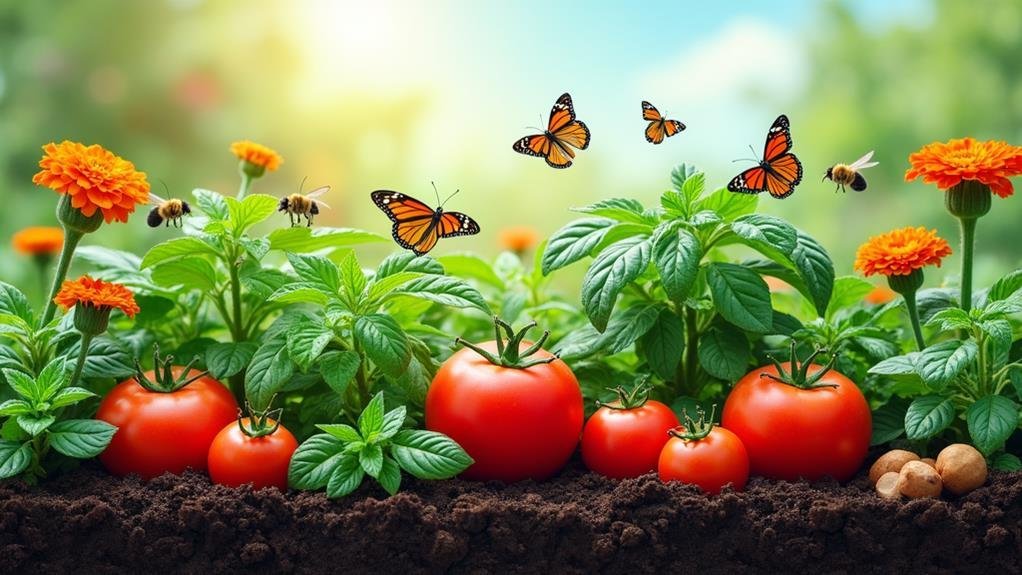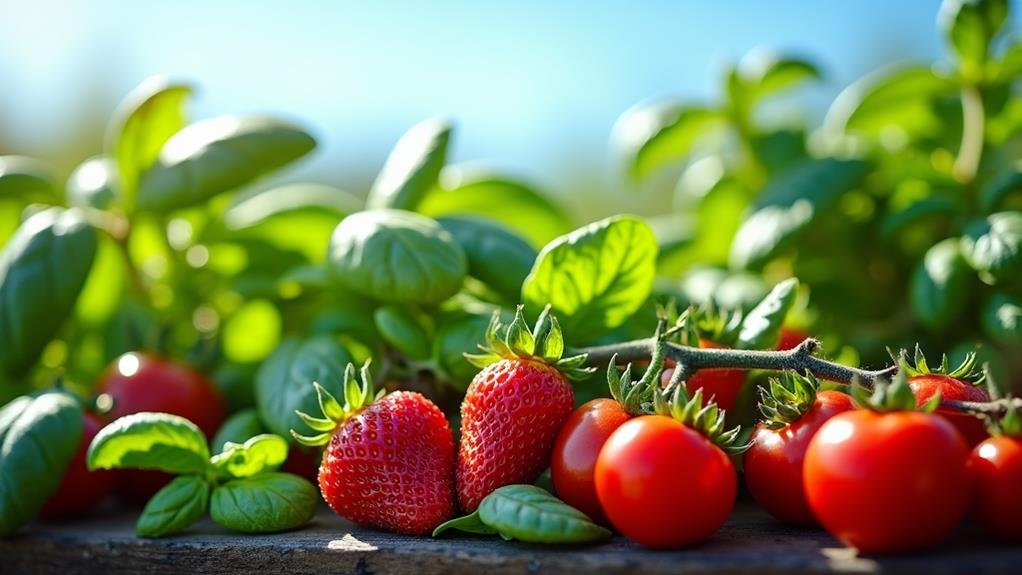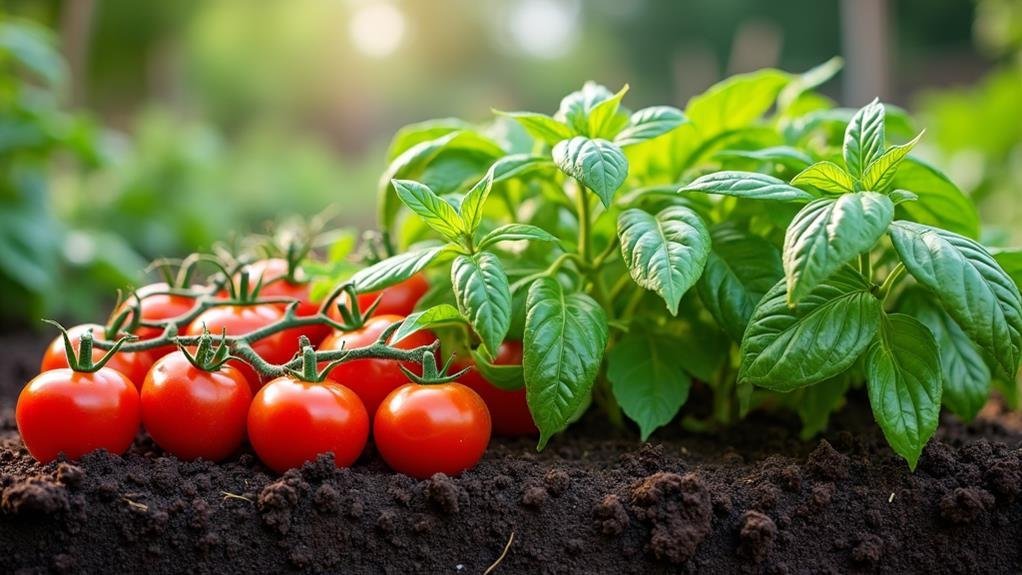When you think about maximizing your garden's potential, companion planting offers a compelling strategy. You might find that certain plants not only thrive together but also improve each other's growth while deterring pests. For example, pairing tomatoes with basil could boost flavor and repel unwanted insects. But that's just the beginning; there are numerous combinations that can transform your gardening experience. Curious about which pairings could be game-changers for your plot?
Benefits of Companion Planting

Companion planting offers a variety of benefits that can boost your garden's health and productivity. By strategically placing plants together, you can create a harmonious ecosystem that supports growth. For example, planting certain vegetables alongside flowers can attract beneficial insects that help control pests. Additionally, some plants can release natural compounds into the soil that benefit their neighboring plants. By utilizing companion planting techniques, you can maximize your garden‘s potential and create a thriving, diverse environment.
One major advantage is pest control. Certain plants naturally repel harmful insects, reducing the need for chemical pesticides. For instance, marigolds are known to deter nematodes, helping your vegetables thrive.
Additionally, companion planting can improve nutrient uptake. Some plants, like legumes, fix nitrogen in the soil, benefiting nearby plants that require this essential nutrient. This can lead to healthier, more robust crops.
You'll also find that certain combinations can boost pollination; flowers attract beneficial insects, which help pollinate your plants, leading to increased yields.
Moreover, companion planting can enhance soil structure and reduce weed growth. By using ground covers, you can suppress weeds while protecting the soil from erosion. This method not only saves you time weeding but also improves moisture retention in your garden.
In short, companion planting is an effective method to create a thriving garden environment. You'll find that with careful planning, your plants will support each other, leading to a more bountiful harvest.
Top Vegetable Pairings
When planning your garden, knowing which vegetables pair well can make a significant difference in your harvest. For instance, tomatoes and basil are a classic pairing. Basil not only improves the flavor of tomatoes, but it also helps repel harmful insects, keeping your tomatoes healthy.
Another great combination is carrots and onions. Planting them together can confuse pests, as the strong aroma of onions masks the sweet scent of carrots. You'll find fewer pests and a more abundant crop.
If you're growing beans, consider planting them alongside corn. The corn provides a natural support system for the climbing beans, while beans enrich the soil with nitrogen, benefiting the corn.
Don't forget about peppers and eggplants. They thrive in similar conditions and share nutrients, making them excellent companions.
Lastly, squash and nasturtiums can create a protective barrier against squash bugs. Nasturtiums attract beneficial insects that help keep pests at bay.
These pairings not only maximize space but also create a healthier garden environment. By strategically choosing your vegetable combinations, you can enjoy a more fruitful and vibrant harvest season.
Herbs That Thrive Together

In your herb garden, certain herbs thrive exceptionally well together, improving each other's growth and flavor. For example, basil and parsley make a fantastic duo. Basil not only repels pests but also boosts the flavor of parsley when grown nearby. You'll love how these two herbs complement each other in your dishes.
Another great pairing is chives and rosemary. Chives deter pests that might harm rosemary, while rosemary's strong scent can improve the flavor of chives. This combination is perfect for adding depth to your culinary creations.
If you're looking to maximize space, consider planting thyme alongside oregano. Both herbs enjoy similar growing conditions and can flourish together in a sunny spot. They'll add a delightful aroma to your garden and your meals.
Don't forget about cilantro and dill! These herbs can coexist beautifully, with cilantro attracting beneficial insects that help deter pests from dill. Planting them together guarantees a thriving and aromatic herb garden.
Experimenting with these combinations can yield a bountiful harvest, making your cooking more enjoyable. Remember, the right companion herbs can truly uplift your gardening experience!
Flowers for Pest Control
Many gardeners are surprised to learn that certain flowers can play a significant role in pest control, just as herbs. By incorporating specific flowers into your garden, you can naturally deter unwanted pests while also adding beauty to your space.
For example, marigolds are a popular choice; their vibrant blooms emit a scent that repels nematodes and aphids, making them excellent companions for your vegetables.
Nasturtiums are another great option. Their peppery leaves not only taste good in salads, but they also attract aphids away from your other plants, acting as a trap crop.
Likewise, cosmos and zinnias can lure beneficial insects like ladybugs and lacewings, which feast on harmful pests.
Planting these flowers around your garden isn't just practical; it's also visually appealing. You'll enjoy the vibrant colors and delightful scents while keeping pests at bay.
Just remember to choose flowers that suit your climate and soil conditions. With a little planning, you can create a thriving garden that's both stunning and pest-resistant.
Fruits That Support Each Other

Companion planting isn't just for flowers; certain fruits can also create a harmonious garden ecosystem. By pairing specific fruits together, you can improve growth, flavor, and even pest resistance.
For instance, strawberries and spinach make a great duo. The spinach provides some shade to the strawberries, keeping their roots cool while you enjoy the delicious berries.
Another fantastic combination is tomatoes and basil. Not only does basil boost the flavor of tomatoes, but it also repels pests like aphids and whiteflies. Plus, the two plants thrive in similar conditions, making it easy to care for them together.
Don't forget about melons and corn! Planting melons near corn allows the corn to support the melons as they grow while benefiting from the shade. This arrangement creates a microclimate that keeps the melons thriving.
Incorporating companion fruits into your garden can lead to a more productive harvest and a healthier growing environment.
Legumes and Nitrogen Fixation
Legumes play an important role in enhancing soil fertility through nitrogen fixation. When you grow legumes, like beans or peas, you're inviting beneficial bacteria into your garden. These bacteria form nodules on the plant roots, where they convert atmospheric nitrogen into a form that plants can use. This process enriches the soil, making it more fertile for future crops.
By including legumes in your planting rotation, you're not just improving the soil; you're also supporting the growth of other plants. When legumes decompose, they release nitrogen, which is crucial for leafy growth. This is why planting legumes alongside heavy feeders, like corn or tomatoes, can yield impressive results.
Don't worry about adding synthetic fertilizers; legumes can naturally replenish the nutrients in your soil. Plus, they're often quite easy to grow, making them a great choice for beginner gardeners.
Just remember to rotate your crops each year, ensuring that you're not planting legumes in the same spot too often. This practice helps maintain soil health and prevents pests and diseases from taking hold.
Companion Planting for Pollinators

To attract pollinators to your garden, strategically planting specific flowers alongside your crops can make a significant difference. Consider incorporating plants like lavender, marigold, and borage, which not only beautify your garden but also draw in bees and butterflies. These vibrant blooms provide essential nectar and pollen, helping to boost the yield of your fruits and vegetables.
When you plant these flowers near your crops, you're creating a welcoming environment for pollinators. For instance, planting sunflowers alongside squash can be particularly effective, as sunflowers attract bees while providing a tall structure for them to land on.
Likewise, interspersing thyme or oregano with your tomatoes can improve pollination, resulting in healthier plants.
Remember to avoid using pesticides, as they can harm these beneficial creatures. Instead, focus on creating a diverse ecosystem that supports not just pollinators, but other beneficial insects as well.
Seasonal Planting Strategies
Understanding seasonal planting strategies can dramatically improve your garden's productivity throughout the year. To start, consider the climate and your local growing season. Planting cool-season crops like lettuce and peas in early spring gives you a head start before the heat arrives.
Once these crops fade, you can switch to warm-season plants like tomatoes and peppers.
Next, think about succession planting. After harvesting a crop, plant another in its place to maximize space and resources. For instance, after you've pulled your early greens, consider sowing a quick-growing summer crop like radishes. This method keeps your garden continuously productive.
Don't forget about crop rotation, either. Changing where you plant certain families of vegetables each season helps prevent soil depletion and reduces pest issues. For example, if you grew brassicas in one bed last year, plant legumes there next season to enrich the soil.
Lastly, pay attention to frost dates. You can extend your growing season by using row covers or cold frames.
Conclusion
Incorporating companion planting into your garden can greatly improve growth and deter pests naturally. By pairing vegetables, herbs, and flowers wisely, you create a thriving ecosystem that supports plant health and reduces the need for chemicals. Remember to reflect on seasonal strategies and the benefits of legumes for nitrogen fixation. With these combinations, you'll not only enjoy a bountiful harvest but also contribute to a sustainable gardening practice that nurtures both your plants and the environment.




